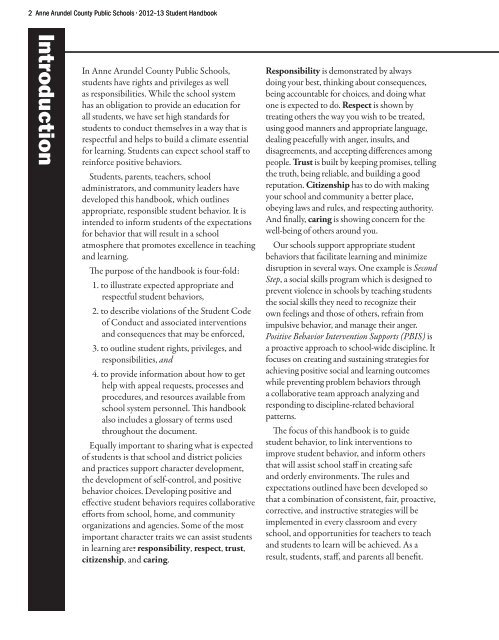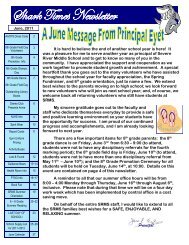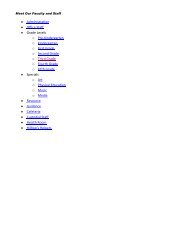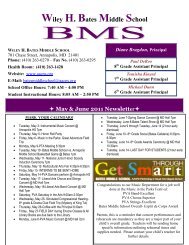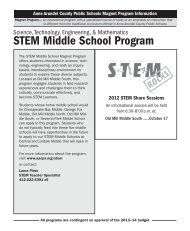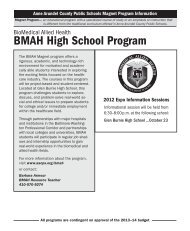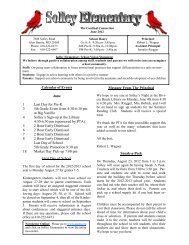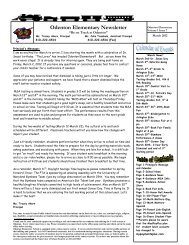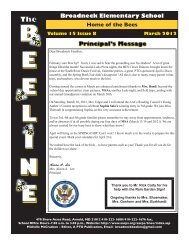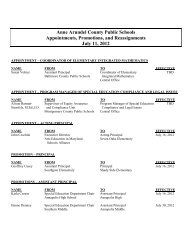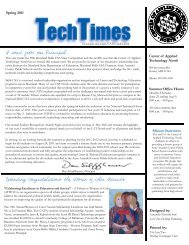Student Handbook - Anne Arundel County Public Schools
Student Handbook - Anne Arundel County Public Schools
Student Handbook - Anne Arundel County Public Schools
You also want an ePaper? Increase the reach of your titles
YUMPU automatically turns print PDFs into web optimized ePapers that Google loves.
2 <strong>Anne</strong> <strong>Arundel</strong> <strong>County</strong> <strong>Public</strong> <strong>Schools</strong> • 2012–13 <strong>Student</strong> <strong>Handbook</strong><br />
Introduction<br />
In <strong>Anne</strong> <strong>Arundel</strong> <strong>County</strong> <strong>Public</strong> <strong>Schools</strong>,<br />
students have rights and privileges as well<br />
as responsibilities. While the school system<br />
has an obligation to provide an education for<br />
all students, we have set high standards for<br />
students to conduct themselves in a way that is<br />
respectful and helps to build a climate essential<br />
for learning. <strong>Student</strong>s can expect school staff to<br />
reinforce positive behaviors.<br />
<strong>Student</strong>s, parents, teachers, school<br />
administrators, and community leaders have<br />
developed this handbook, which outlines<br />
appropriate, responsible student behavior. It is<br />
intended to inform students of the expectations<br />
for behavior that will result in a school<br />
atmosphere that promotes excellence in teaching<br />
and learning.<br />
The purpose of the handbook is four-fold:<br />
1. to illustrate expected appropriate and<br />
respectful student behaviors,<br />
2. to describe violations of the <strong>Student</strong> Code<br />
of Conduct and associated interventions<br />
and consequences that may be enforced,<br />
3. to outline student rights, privileges, and<br />
responsibilities, and<br />
4. to provide information about how to get<br />
help with appeal requests, processes and<br />
procedures, and resources available from<br />
school system personnel. This handbook<br />
also includes a glossary of terms used<br />
throughout the document.<br />
Equally important to sharing what is expected<br />
of students is that school and district policies<br />
and practices support character development,<br />
the development of self-control, and positive<br />
behavior choices. Developing positive and<br />
effective student behaviors requires collaborative<br />
efforts from school, home, and community<br />
organizations and agencies. Some of the most<br />
important character traits we can assist students<br />
in learning are: responsibility, respect, trust,<br />
citizenship, and caring.<br />
Responsibility is demonstrated by always<br />
doing your best, thinking about consequences,<br />
being accountable for choices, and doing what<br />
one is expected to do. Respect is shown by<br />
treating others the way you wish to be treated,<br />
using good manners and appropriate language,<br />
dealing peacefully with anger, insults, and<br />
disagreements, and accepting differences among<br />
people. Trust is built by keeping promises, telling<br />
the truth, being reliable, and building a good<br />
reputation. Citizenship has to do with making<br />
your school and community a better place,<br />
obeying laws and rules, and respecting authority.<br />
And finally, caring is showing concern for the<br />
well-being of others around you.<br />
Our schools support appropriate student<br />
behaviors that facilitate learning and minimize<br />
disruption in several ways. One example is Second<br />
Step, a social skills program which is designed to<br />
prevent violence in schools by teaching students<br />
the social skills they need to recognize their<br />
own feelings and those of others, refrain from<br />
impulsive behavior, and manage their anger.<br />
Positive Behavior Intervention Supports (PBIS) is<br />
a proactive approach to school-wide discipline. It<br />
focuses on creating and sustaining strategies for<br />
achieving positive social and learning outcomes<br />
while preventing problem behaviors through<br />
a collaborative team approach analyzing and<br />
responding to discipline-related behavioral<br />
patterns.<br />
The focus of this handbook is to guide<br />
student behavior, to link interventions to<br />
improve student behavior, and inform others<br />
that will assist school staff in creating safe<br />
and orderly environments. The rules and<br />
expectations outlined have been developed so<br />
that a combination of consistent, fair, proactive,<br />
corrective, and instructive strategies will be<br />
implemented in every classroom and every<br />
school, and opportunities for teachers to teach<br />
and students to learn will be achieved. As a<br />
result, students, staff, and parents all benefit.


